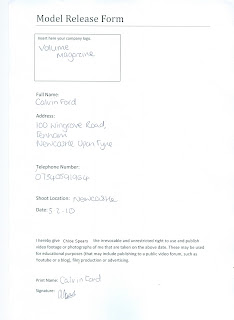Model: Lauren Hall
Below is two images that I will use for my double page spread. The first, show two versions of the image I intend to use for my main A4 spread, on the left hand side of the double page. I have chosen to use a medium close up of my main female singer, to introduce the readers to ideologies about her dominance and status within the band. Along with this, it challenges gender stereotypes . The image renders her as sexual icon to a young male audience, which is perceived through her positioning, pose, costume and make up. Her low cut top, long flowing hair and large amount of make up reinforces her sexual prerogative and reinforces gender stereotypes. From my research, I found similar images which conform to these stereotypes, such as Hayley Williams from Paramore and Cassade Pope from Hey Monday.
Examples of this:

The image below is an edited version of my main raw image, in which I have inserted a black banner diagonally across the image. I have altered the opacity of the banner, so the reader is still able to recognize the image underneath. I have also used a quote from my article, which is in white font, with red paint splashes which adds colour and vibrance to the image.
The image below is a further edited image, which I constructed after my pitch feedback - which was to brighten the full image, add more brushes and a title at the top of the page. Whilst doing this, I found this introduced the band featured much more clearer, as it was now at the top of the page. It also stands out more, and hides some of the original dull location background.
Models: Calvin Ford, Lauren Hall, Sabih Khan
The other is a medium close up all 3 band members, which allows the audience to recognize the other members of the band, along with the main female lead singer. Also, on the other photograph, we can recognise that her eyeline shows direct address with the reader. This engages the reader to feel the photograph was taken for them, therefor involving them in the magazine. With the other two members, stereotypical representations of band members of this genre are also present. On the left, the models eye line is not direct address, which challenges the readers perseption, which suggests he is daring, fun and exciting and possibly childlike. On the right, the model represents the dominant male role, direct address and sleek and smart hair suggests he is a flirt, a ladies man which immediatly appeals to an female audience for my magazine.


















































